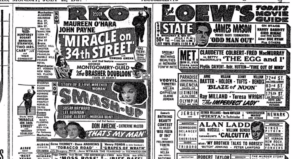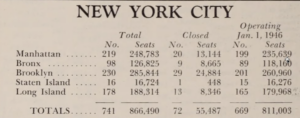1957 Levittown, New York
Bruce Goldstein
1952
Levittown, New York
Interviewed on February 8, 2022
by Brian Sun

My father worked at Columbia Pictures, in the art department. He would bring home promotional things, like LPs—I still have them for some of the movies from the late fifties—and one of them was for a movie called Pal Joey with Frank Sinatra from 1957. I was five years old. We’d play this record, and I’d memorize all of the songs. So I’m five, and I’m singing these songs around the house, and they were all really risqué songs by Rodgers and Hart—Pal Joey was kind of an adult movie for the time.
Then one day, without telling me, my parents took me to a movie theater for the first time, the Levittown Theater—Levittown’s a community on Long Island. It was a complete surprise for me, and when we got there we watched Pal Joey, with all of the songs that I memorized, and I’m singing them in my seat along with the movie. But that was my earliest film, Pal Joey, I believe.
And then later, my mother would take me to the movies, so I saw a lot of women’s pictures. I didn’t see Disney movies, or kiddie movies a lot. I remember taking her taking me to see Imitation of Life, a Douglas Sirk movie, at the Meadowbrook Theater, in East Meadow, New York. I just remember being dazzled by opening credits with the jewels and the big screen; it left an impression on me.
I saw a lot at the Meadowbrook Theater. Again, I didn’t see the Disney animated movies at all, because Disney only released them every seven years. I was an adult before I saw Pinnochio and Snow White and all those films. But I saw a film called The Shaggy Dog and one I loved called The Absent-Minded Professor with Fred MacMurray about inventing something called flubber, an early special effects movie—that was fabulous. 
Screenings in Manhattan
If you lived in the city, if you lived in Manhattan, you could walk to the theaters. For the the city was about a forty minute train ride, which was still accessible. But I wanted to show you that theaters were truly everywhere in New York. [Above] you see the directory directory ads that used to appear every day in The New York Times, showing you what double-features were playing at what theaters in the chain, and you notice that there’s quite a few! You had a lot of choices. 
Theaters in New York
So this is from some yearbook in 1947 I believe. There were 219 movie houses in Manhattan alone with 235,639 seats. You could see that every neighborhood had a theater or two—it was easy to go to the movies in New York. And you know, the first run films normally opened on Broadway—the big movies—so at the beginning of the run you’d go to Broadway, but they’d eventually end up in the neighborhoods.
I don’t remember ushers in these Long Island theaters. However, I remember ushers at Radio City Music Hall, now that was something. They were like an army; they had like military bearing. They had ranks and everything. At the end of the night, they would go through all of Radio City Music Hall, which is over 6,000 seats, and like a military drill, they would push up all the seats in the entire theater to see if anyone left anything. And they were all dressed in those usher uniforms of the thirties.
I do remember one thing we had in New York theaters though—matrons. The matron was a person, normally an older woman, who by state law, or maybe city law, supervised the children in the cinema. Kids could only sit in certain sections, the children’s section, if they were not accompanied by parents. And the matron would supervise them. It was always the lousy seats, so we would always sneak out to the other seats, because when you get to a certain age, say ten or eleven, you start going to the theater without your parents, with your friends.
I don’t recall any candy at all. I think we brought our own. My mother snuck in our own popcorn. I remember being on the balcony—a lot of theaters had balconies at those days—go on the balcony and you’d throw things down. There was a reason there was a matron. Movie theaters were an excuse for kids to run wild, and they were really raucous; they would go up on the balcony and throw popcorn on the heads of friends sitting below. Things like that.
I remember at the Meadowbrook theater, I was with my cousin; we found a button that actually turned the lights on and off in the theater, and we pushed the button in the middle of this movie and we ran out. And the lights in the whole weather went up. Meadowbrook — was a really nice theater. Right next to the theaters, like the Meadowbrook theater, there was a little old-fashioned ice cream parlor, Jahn’s, and we would go there and have ice cream. That was the theater I loved going to the most—I remember seeing a revival of The African Queen there.
All of the early movies that I saw made an impression on me. What … Marx brothers. Silent comedies, Buster Keaton—Harold Lloyd’s World of Comedy. You don’t expect to see comedy in a drive-in, because part of watching comedy in a theater is sharing the humor with the audience. But I could hear the laughs through the cars! Harold Lloyd did not release his films on television—you could see early, early Chaplin on television, and we knew Chaplin really well—you could see The Gold Rush. Of course we idolized Chaplin. We saw a little bit of Keaton in compilation films like Days of Thrills and Laughter. But those are the films that stay with me forever. That defines a classic.
